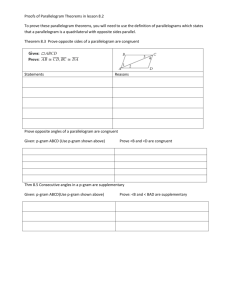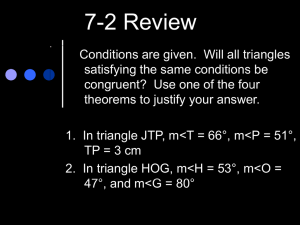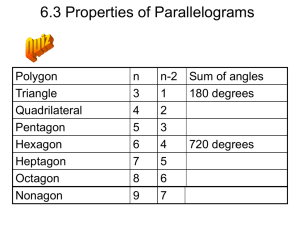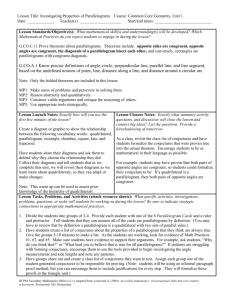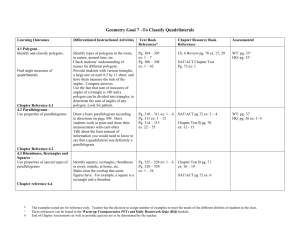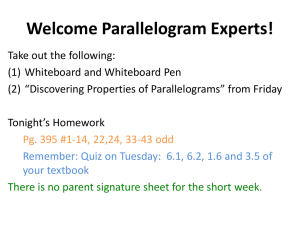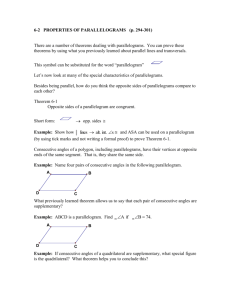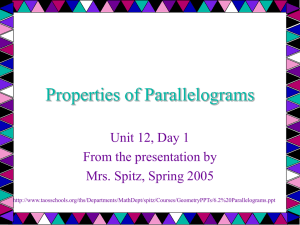Digital Agenda Week of … November 12 Check In/Do Now: 1. Grade
advertisement
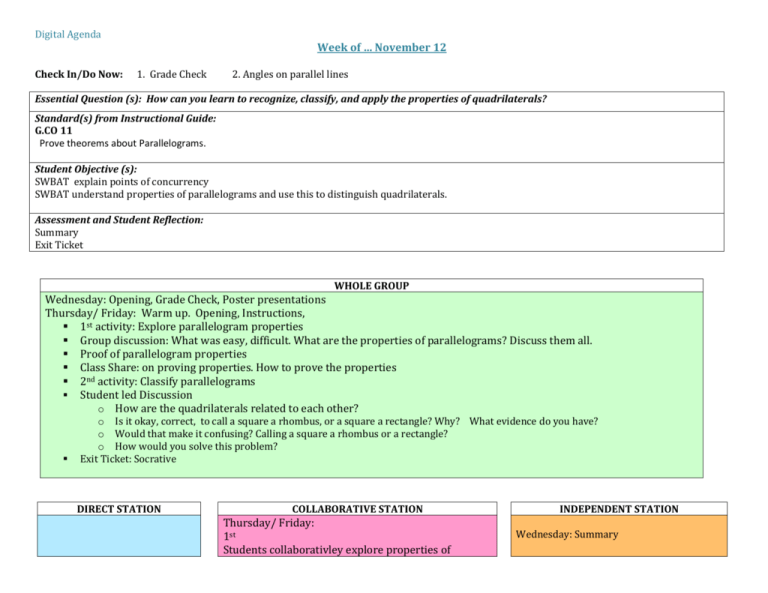
Digital Agenda Check In/Do Now: Week of … November 12 1. Grade Check 2. Angles on parallel lines Essential Question (s): How can you learn to recognize, classify, and apply the properties of quadrilaterals? Standard(s) from Instructional Guide: G.CO 11 Prove theorems about Parallelograms. Student Objective (s): SWBAT explain points of concurrency SWBAT understand properties of parallelograms and use this to distinguish quadrilaterals. Assessment and Student Reflection: Summary Exit Ticket WHOLE GROUP Wednesday: Opening, Grade Check, Poster presentations Thursday/ Friday: Warm up. Opening, Instructions, 1st activity: Explore parallelogram properties Group discussion: What was easy, difficult. What are the properties of parallelograms? Discuss them all. Proof of parallelogram properties Class Share: on proving properties. How to prove the properties 2nd activity: Classify parallelograms Student led Discussion o How are the quadrilaterals related to each other? o Is it okay, correct, to call a square a rhombus, or a square a rectangle? Why? What evidence do you have? o Would that make it confusing? Calling a square a rhombus or a rectangle? o How would you solve this problem? Exit Ticket: Socrative DIRECT STATION COLLABORATIVE STATION Thursday/ Friday: 1st Students collaborativley explore properties of INDEPENDENT STATION Wednesday: Summary parallelogram through web based visual models to make conjectures(statements) about the parallelograms based on their observations. This is followed by students completing practice problems. Proof of parallellogram properties: students work in their groups to prove the properties of parallelogram. Steps 1. Draw a diagonal line segment from the two opposite vertices. 2. Notice the two triangles in the paralleligram? Prove them Congruent. You may use the postulates and theorems or transformations. (for the transformations proof you need to create the midpoint on the diagonal). 3. Show that the property is true 2nd Activity: classify parallelograms Students conintue to look at properties of all parallelograms and fill out the graphic organizer provided to them. This organizer will help students in classifying triangles WITH JUSTIFICATION in their practice problems. Thursday/ Friday: Socrative Exit ticket On a laptop go to http://tinyurl.com/mk76w3x Exploring Properties of Parallelograms You can move any of the sides or vertices of the parallelogram by dragging them. Try to change the shape of the quadrilateral. The options on the right of the figure will add things to the parallelogram, select them to see what happens. Using this parallelogram as a team to make conjectures about the properties of parallelograms. Select the options on the right of the figure, try one at a time, to help you in creating the conjectures (statements). Communicate with your group members during this exploration to share ideas and thoughts about the properties of parallelograms. Write a conjecture about the properties of parallelograms in your notebooks. Use the sentence below to help you create your conjecture. As you create your conjectures share them. Example: If a quadrilateral is a parallelogram, then the opposite sides are parallel. 1. What do you notice about the opposite sides of the parallelogram? 2. What do you notice about the diagonals of a parallelogram as they intersect one another? 3. What do you notice about the opposite angles in a parallelogram? 4. What do you notice about the consecutive angles, angles on the same line, in a parallelogram? Practice problems: Complete the practice problems with your team members. Group Discussion Have a discussion with your group members about the conjectures that you made. Share the conjectures (properties of parallelograms) that were made and explain how it was made. Make sure that everyone in the group understands the properties. Proof of the parallelogram properties As a group you will prove the properties of parallelograms which you just explored. You may only assume that the opposite sides are parallel. Do not use any other properties of parallelograms in your proof. Given that ADCB is a parallelogram Prove one of the properties of parallelograms. a) Opposite sides are congruent b) Opposite angles are congruent c) Consecutive angles are congruent angles A&B, A&D, D&C, or C&B Steps 1. Draw a diagonal line segment from the two opposite vertices. 2. Notice the two triangles in the paralleligram? Prove them Congruent. You may use the postulates and theorems or transformations. (for the transformations proof you need to create the midpoint on the diagonal). 3. Show that the property is true Special parallelograms: rhombi , rectangles, and squares. Go to Rhombus :http://tinyurl.com/nqdrqzl Rectangles http://tinyurl.com/n7d29w4 Square http://tinyurl.com/pgvfooj Pairs of student in the group will go to one of the websites above. Each student will explore one of the quadrilaterals by selecting the options next to the figure and creating new conjectures (just like before). Each student will explain what new conjectures they created from the exploring their quadrilateral. Share the conjectures you made with your group. Example: If a quadrilateral is a square, then it has all the properties of a parallelogram. Graphic Organizer Use the graphic organizer given to you and fill it in with any properties you might have missed. Practice Problems: Complete the practice problems with your team members by using the graphic organizer
